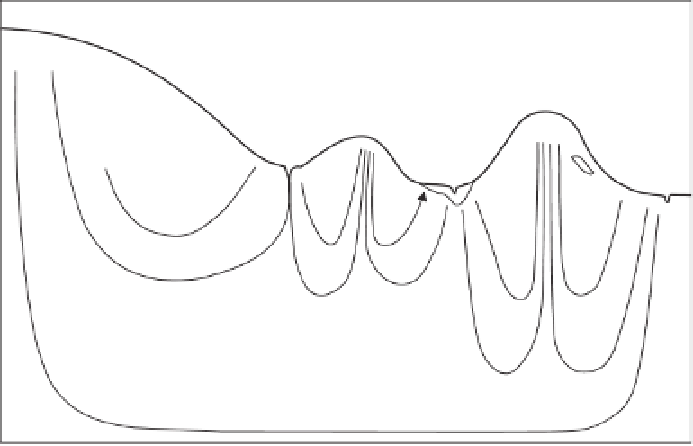Environmental Engineering Reference
In-Depth Information
Sandy ridge
Sandy ridge
water flow pattern
mineral-poor
boulder clay
clay
mineral-rich
Figure 5.4
Changes in groundwater composition along its way through the subsoil. Mineral-poor rainwater infi ltrates the
subsoil and takes up solutes along the way. Arrows indicate direction of water fl ow; darkness increases with mineral content
of the groundwater.
Rhine River at the German-Dutch border, for example,
has increased from circa 100 × 1 0
6
kg of N in the period
1954-1957 to more than 150 × 1 0
6
kg of N in the period
1993 - 1995 (Behrendt 1997 ).
In densely populated regions, deliberate transport of
matter is probably quantitatively more important than
natural fl ows. As a result, natural differences between
landscapes fade away and the boundaries between differ-
ent areas of countryside become increasingly blurred.
Broadly stated, organisms that are adapted to moist and
eutrophic conditions are stimulated, whereas other types
of organism are hampered. This trend is especially pro-
nounced in easily cultivated - that is, generally fl at -
areas. Mountainous regions are much more diffi cult
to cultivate, and
geomorphology
- based differences
between landscapes are much better preserved there.
sal by wind is uncommon in most areas, and occurs
only under exceptional conditions (Nathan 2006).
Examples include thermal updrafts generated by large
fi res (Whelan 1986) or extremely strong winds such as
cyclones (Visher 1925). Under more average condi-
tions seeds are not lifted up by the wind and the dis-
tances travelled depend on the horizontal wind speed
and the characteristic speed of fall of the species (ter-
minal velocity). Studies in wind tunnels (van Dorp
et al
.
1996 ; Soons & Bullock 2008 ), modelling approaches
(Bullock & Clarke 2000 ) and fi eld studies (Verkaar
1990 ; Coulson
et al
. 2001) found that under such con-
ditions only a very small fraction of the seeds reached
distances of more than 10-20 m from the parent
plants. This fraction is larger in the case of species that
produce large numbers of very light seeds and/or high
above the surface of the ground, for example large
marsh plants such as
Phragmites australis
and
Typha
angustifolia
(Table 5.2) or trees. Species with extremely
small seeds such as orchids, or those bearing spores,
like mosses and ferns, have better prospects for long-
distance dispersal by wind.
The importance of wind dispersal changes dramati-
cally in more heterogeneous landscapes. Steep slopes
and irregular warming of diverse surface materials
enhance the importance of thermal updrafts for airfl ow.
5.3.2
Dispersal of organisms
By a irfl ows
In fl at, homogeneous landscapes, wind transport of
organisms is diffuse and little affected by existing cor-
ridors. Despite a general assumption that wind is an
important long-range dispersal vector for plants, the
available evidence suggests that long-distance disper-























